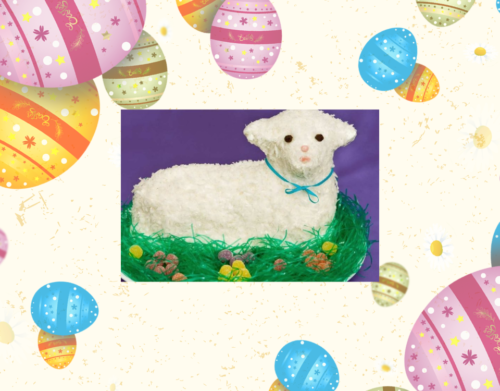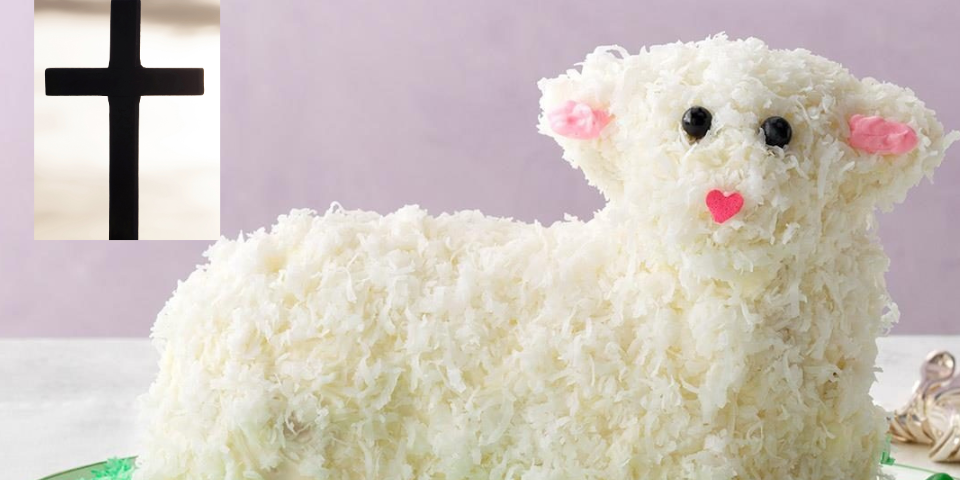
Burger King Lunch Menu Deals
March 2, 2024
homemade chicken noodle soup best recipe for a cold
April 24, 2024What is the tradition of lamb cake on Easter?
The tradition of the Easter lamb cake finds its roots in Polish and other Eastern European customs. This delightful cake is baked in a lamb-shaped mold, adorned with frosting, candied eyes, and coconut grass.
What is the tradition of lamb cake on Easter?
The tradition of baking lamb cakes traces its roots to Europe. In countries like Poland, Germany, and Greece, families have been creating these edible lambs for centuries. The lamb symbolizes purity, sacrifice, and resurrection-themes central to the Easter celebration.
As immigrants brought their customs to America, the tradition of baking lamb cakes crossed the Atlantic. Today, you will find these delightful treats gracing Easter tables in diverse communities, from New York to California.
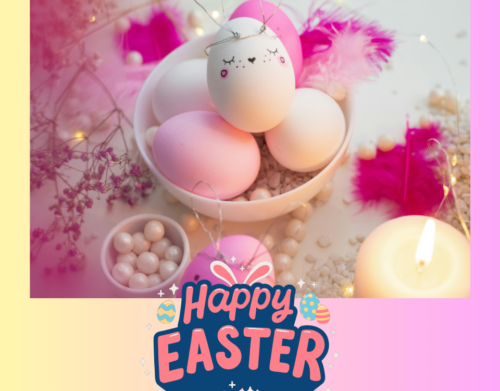
Easter Lamb Cake Tradition
- Gathering Ingredients: As Easter Sunday approaches, families gather in their kitchens. Flour dust countertops, butter softens, and eggs crack. The act of baking becomes a communal experience—a way to connect with loved ones and honor tradition.
- The Blessing: Before slicing into the lamb cake, some families say a prayer or offer a blessing. It’s a moment of reverence, acknowledging the deeper meaning behind this delightful dessert.
- Passing Down Recipes: Grandmothers teach their grandchildren the secrets of lamb cake baking. These recipes are cherished heirlooms, preserving memories of past celebrations.
- A Table Centerpiece: The lamb cake takes center stage on Easter Sunday. It stands proudly amidst colored eggs, fresh flowers, and other festive decorations. As families gather around the table, they share stories, laughter, and gratitude.
As springtime arrives and Easter gets closer, families everywhere get ready for a fun tradition, making cakes that look like lambs. These cute cakes have a special meaning in our culture and have been passed down from one generation to another. Let’s explore the interesting history, meaning, and creativity behind Easter lamb cakes.
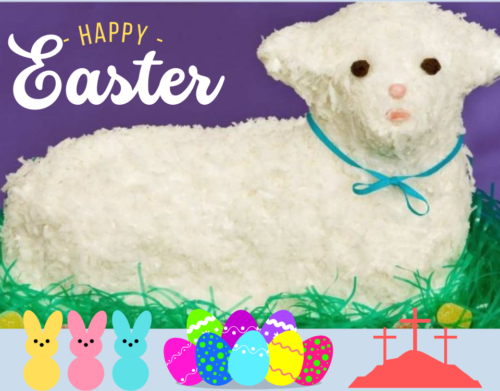
The Symbolism and History of Lamb Cakes
Let’s explore its history:
- Ancient Origins: The Easter holiday is deeply connected to the Christian celebration of Jesus Christ’s resurrection. Lambs symbolize both sacrifice and new life. In the past, actual lambs were often part of Easter feasts.
- No Meat on Religious Holidays: However, the Catholics had a tradition of avoiding meat on religious holidays like Easter. To comply, rather than serving actual lamb, people began making cakes shaped like lambs to enjoy during these occasions.
- Mid-20th Century Craze: From the mid-1920s to the 1970s, Chicago’s Dinkel’s bakery churned out thousands of lamb cakes each season. Nowadays, this tradition has waned, but some still cherish it.
- The Lamb as a Symbol: In Christian beliefs, Jesus is often likened to the “Lamb of God.” This symbolizes innocence, redemption, and the supreme sacrifice. As Easter marks Jesus’ resurrection, the lamb cake serves as a sugary reminder of this significant occasion.
- The Mold and Technique: Baking a lamb cake involves using a special lamb-shaped mold. Traditionally, these molds were made of cast iron or aluminum. The batter is poured into the mold, and after baking, the cake emerges with intricate details—the lamb’s wool, face, and hooves. The process requires patience and skill, making it a cherished family activity.
- Decorating with Precision: Once baked, the lamb cake is adorned with white icing or powdered sugar, symbolizing purity. Some bakers add coconut flakes to mimic the lamb’s wool. Eyes and a gentle smile are carefully piped, giving the cake a lifelike appearance.
- Variations: While most lamb cakes are pound cakes or sponge cakes, regional variations exist. Some families infuse the cake with almond or lemon flavors, while others add raisins or currants for texture.
- Texture and Flavor: Achieving the fluffy texture of a lamb involves adding coconut to the creamy white frosting. While some adore it, others avoid it due to coconut aversion.
- Variety of Lamb Cakes: There are different ways to bake a lamb cake—vanilla pound cake, chocolate, and even red velvet versions. Each family may have its cherished recipe.
Easter lamb cake Recipe:
Making an Easter Lamb Cake is a delightful tradition. Let’s create a cute lamb-shaped cake that will be the centerpiece of your Easter celebration.
Ingredients:
- 1 cup (2 sticks) unsalted butter, softened
- 2 cups granulated sugar
- 4 large eggs
- 3 cups all-purpose flour
- 1 tablespoon baking powder
- 1/2 teaspoon salt
- 1 cup buttermilk
- 1 teaspoon vanilla extract
Instructions:
Step 1: Prepare the Pan
- Grease the inside of your lamb-shaped Pan using a pastry brush and solid vegetable shortening (avoid using butter or liquid vegetable oil).
- Sprinkle flour inside the pan, shake it around, and then tap lightly to remove any excess flour. Ensure every nook and cranny is well-greased and floured.
Step 2: Make the Batter:
- Start by creaming softened butter and sugar together until the mixture becomes light and fluffy.
- Add the eggs one at a time, beating well after each addition.
- In a separate bowl, combine the flour, baking powder, and salt.
- Gradually add the dry ingredients to the butter mixture, alternating with buttermilk and vanilla. Mix everything until well combined.
Step 3: Fill the Pan
- Pour 6 cups of batter into the front half of the lamb cake pan (the side without the small vent hole). The batter should come right to the rim, almost overflowing.
- Snap the other half of the pan in place and tie it tightly together with baker’s twine. You might also want to consider placing aluminum foil on the bottom rack of your oven to catch any batter that may seep through while baking.
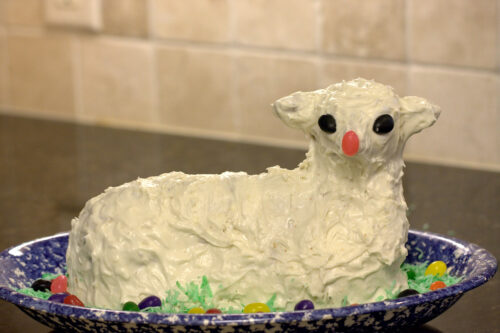
Step 4: Baking
- Preheat your oven to 350°F (180°C).
- Bake the lamb cake for 50-60 minutes. To check if it’s done, insert a toothpick through the vent hole. If it comes out clean, your cake is ready.
- Remove the cake from the oven and let it cool in the pan on a cooling grid for 5 minutes.
- Remove the top half of the pan and let it cool for 5 more minutes.
- Replace the top pan, turn the cake over, and remove the bottom pan. Gently tap the pan with the handle of a spatula to free the cake.
Step 5: Decorate
- Once the cake is completely cool, it’s time to get creative.
- Use white frosting to cover the lamb shape—this will be your lamb’s wool.
- Add coconut flakes for a fluffy coat, chocolate chips for the eyes, and licorice lace for the mouth.
- Finally, place your adorable lamb cake on a serving platter and enjoy this delightful Easter treat.
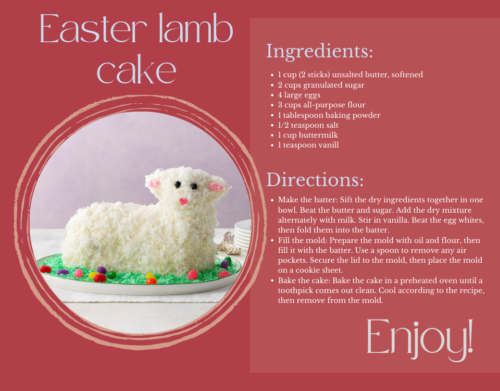
FAQ:
Why is a lamb cake associated with Easter?
The tradition of the Easter lamb cake is rooted in Polish and Eastern European customs. It symbolizes both sacrifice and new life, reflecting the Christian celebration of Jesus Christ’s resurrection. Rather than consuming an actual lamb, people bake a cake shaped like one.
What is the significance of the lamb at Easter?
The lamb symbolizes purity, innocence, and sacrifice. In Christian theology, Jesus is often referred to as the Lamb of God, emphasizing His role as the ultimate sacrifice for humanity’s sins.
Should you eat lamb at Easter?
While it’s not a strict requirement, some people choose to eat lamb during Easter as a nod to the symbolism. However, dietary preferences and cultural practices vary.
What does the lamb symbolize in Easter?
The lamb represents Christ’s sacrifice and resurrection. It refers to ancient Jewish traditions of offering lambs during Passover and connects to the Christian narrative of redemption.
What does the Lamb represent most?
The Lamb represents innocence, purity, and divine sacrifice. It holds deep spiritual significance across various religious contexts.
Where is lamb cake popular?
Lamb cakes were particularly popular in Chicago, especially from the mid-1920s to the 1970s. However, this tradition has waned over time, and it’s not as widespread today.
Why is the lamb a symbol of Easter?
The symbolism of the lamb during Easter holds deep significance, intertwining religious beliefs and cultural traditions. Let’s explore why the lamb is a cherished emblem of this sacred holiday:
- Lamb of God: In the Christian tradition, the phrase “Lamb of God” originates from the Bible. In the Gospel of John (John 1:29), John the Baptist proclaims, “Behold, The Lamb of God, who takes away the sin of the world!” This proclamation refers to Jesus Christ, with whom the lamb becomes symbolically linked. The lamb represents purity, innocence, and sacrifice.
- Old Testament Symbolism: Throughout the books of the Bible, particularly the Old Testament, the lamb appears repeatedly. From the story of Abraham and Isaac to the Passover, where the lamb’s blood was painted over doorways for protection, the lamb symbolizes sacrifice and service toward God. John the Baptist, being of the Jewish faith, understood the weight of his proclamation about Jesus as the Lamb of God.
- Jesus’ Sacrifice: Just as lambs were offered as sacrifices in ancient times, Jesus’ eventual sacrifice for humanity’s sins is symbolically represented by the lamb. The lamb’s purity mirrors Christ’s goodness and salvation. As Christianity grew, the practice of sacrificing animals diminished, but the tradition of eating lamb at Easter persisted. It serves as a poignant reminder of Jesus’ triumph after rising from the dead.
- Easter Lamb Meals: Many cultures incorporate lamb into their Easter meals. Whether it’s roasted lamb, braised lamb leg, lamb stew, or lamb cassoulet, this flavorful meat continues to hold significance as a symbol of sacrifice. Despite commercialization, the lamb remains a powerful reminder for Christians of the true essence of Easter.
